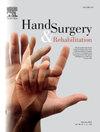Morbidity of surgical techniques for radioscapholunate fusion in radiocarpal osteoarthritis
IF 0.9
4区 医学
Q4 ORTHOPEDICS
引用次数: 0
Abstract
Radioscapholunate (RSL) arthrodesis is a treatment option for radiocarpal osteoarthritis in conditions such as post traumatic osteoarthritis after intra-articular distal radius fracture, stage 2 SLAC wrist, Kienbock's disease, and rheumatoid arthritis. Fusion can be achieved by various techniques such as fixation by K-wires, staples, plates and screws, with or without bone grafting, with no standard fixation technique currently established. We performed a retrospective analysis of patients treated with radioscapholunate fusion in our institution to analyze the morbidity of the different surgical techniques.
We performed a retrospective data analysis of patients treated with RSL fusion for radiocarpal osteoarthritis in our institution between 2013 and 2023.
20 patients underwent RSL fusion; 3 with rheumatoid arthritis and 17 with post-traumatic radiocarpal osteoarthritis. Fixation was performed with screws in 11 cases (55%), with plates and screws in 6 cases (30%) and with plates in 3 cases (15%). In 17 cases (85%), bone graft was inserted in the fusion zone, mostly from distal radius (25%) or iliac crest (20%). The mean range of motion (ROM) of the affected wrist decreased from 81° preoperatively to 53° postoperatively, grip strength decreased from 25 kg preoperatively to 21 kg postoperatively. 8 cases (40%) showed a total of 11 complications during follow up, all of them were revised surgically. The most common complications were conflict of hardware with soft tissue or joint surface (36%, 4 cases), followed by non-union and pancarpal arthritis (each 18%, 2 cases), one seroma of the iliac crest, one lunohamatal conflict and one tendon irritation. 2.4 mm plates were used for fusion in 3 of the 4 cases suffering from conflict with the hardware. Both cases of non-union occurred in heavy smokers with over 30 pack years.
We observed a slightly higher fusion rate of 90% compared to the literature, with only two cases of non-union heavy smokers. There was no significant difference in complication rate or severity between the surgical techniques, however the majority of the complications were observed in patients treated with dorsal plates as fusion material. This can be explained by the hardware prominence, which causes conflict and irritation of the surrounding tissue.
Hardware-related complications, non-union and pancarpal osteoarthritis remain the main problems in RSL fusion. The hardware prominence can increase the risk of conflict with the surrounding soft tissue. We therefore recommend the use of screws or anatomically adapted low-profile plates for fusion.
桡腕骨关节炎桡舟月骨融合术手术技术的发病率
桡舟月骨(RSL)关节融合术是桡腕骨关节炎的一种治疗选择,如关节内桡骨远端骨折后创伤性骨关节炎、2期SLAC腕关节、Kienbock病和类风湿性关节炎。融合可以通过各种技术实现,如用k针、钉、钢板和螺钉固定,有或没有植骨,目前没有建立标准的固定技术。我们对我院接受桡舟月骨融合术治疗的患者进行回顾性分析,以分析不同手术技术的发病率。我们对2013年至2023年间我院接受RSL融合治疗桡腕骨关节炎的患者进行了回顾性数据分析,其中20例患者接受了RSL融合;3例类风湿关节炎,17例创伤后桡腕骨关节炎。采用螺钉固定11例(55%),钢板+螺钉固定6例(30%),钢板固定3例(15%)。17例(85%)在融合区植入植骨,主要来自桡骨远端(25%)或髂骨(20%)。受影响手腕的平均活动范围(ROM)从术前的81°下降到术后的53°,握力从术前的25 kg下降到术后的21 kg。8例(40%)术后随访共出现11例并发症,均行手术治疗。最常见的并发症是硬体与软组织或关节面冲突(36%,4例),其次是骨不连和胰腺关节炎(各18%,2例),髂嵴血清肿1例,月间冲突1例,肌腱刺激1例。4例中有3例与内固定物发生冲突,采用2.4 mm钢板进行融合。这两例骨不连均发生在吸烟年龄超过30年的重度吸烟者中。与文献相比,我们观察到融合率略高,为90%,只有2例重度吸烟者不愈合。两种手术技术在并发症发生率和严重程度上没有显著差异,但大多数并发症发生在使用背钢板作为融合材料的患者中。这可以用硬体突出来解释,硬体突出会引起周围组织的冲突和刺激。硬体相关并发症、骨不愈合和胰腺骨关节炎仍然是RSL融合的主要问题。硬体突出会增加与周围软组织发生冲突的风险。因此,我们建议使用螺钉或适合解剖结构的低轮廓钢板进行融合。
本文章由计算机程序翻译,如有差异,请以英文原文为准。
求助全文
约1分钟内获得全文
求助全文
来源期刊

Hand Surgery & Rehabilitation
Medicine-Surgery
CiteScore
1.70
自引率
27.30%
发文量
0
审稿时长
49 days
期刊介绍:
As the official publication of the French, Belgian and Swiss Societies for Surgery of the Hand, as well as of the French Society of Rehabilitation of the Hand & Upper Limb, ''Hand Surgery and Rehabilitation'' - formerly named "Chirurgie de la Main" - publishes original articles, literature reviews, technical notes, and clinical cases. It is indexed in the main international databases (including Medline). Initially a platform for French-speaking hand surgeons, the journal will now publish its articles in English to disseminate its author''s scientific findings more widely. The journal also includes a biannual supplement in French, the monograph of the French Society for Surgery of the Hand, where comprehensive reviews in the fields of hand, peripheral nerve and upper limb surgery are presented.
Organe officiel de la Société française de chirurgie de la main, de la Société française de Rééducation de la main (SFRM-GEMMSOR), de la Société suisse de chirurgie de la main et du Belgian Hand Group, indexée dans les grandes bases de données internationales (Medline, Embase, Pascal, Scopus), Hand Surgery and Rehabilitation - anciennement titrée Chirurgie de la main - publie des articles originaux, des revues de la littérature, des notes techniques, des cas clinique. Initialement plateforme d''expression francophone de la spécialité, la revue s''oriente désormais vers l''anglais pour devenir une référence scientifique et de formation de la spécialité en France et en Europe. Avec 6 publications en anglais par an, la revue comprend également un supplément biannuel, la monographie du GEM, où sont présentées en français, des mises au point complètes dans les domaines de la chirurgie de la main, des nerfs périphériques et du membre supérieur.
 求助内容:
求助内容: 应助结果提醒方式:
应助结果提醒方式:


